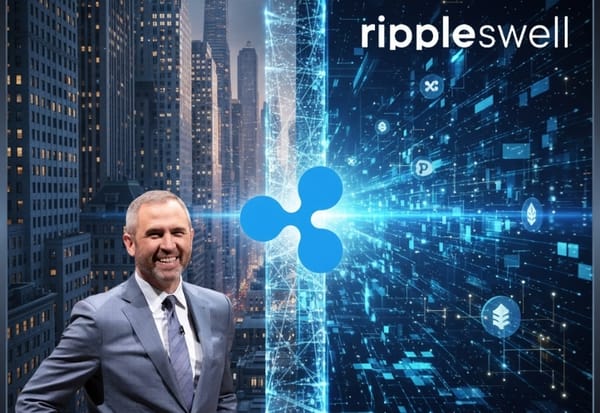Why the Market Misprices XRP: Infrastructure, Not Just a Token
XRP isn’t just a speculative token—it’s the infrastructure for global finance. As the market wakes up to its utility in cross-border payments and tokenized assets, price discovery could accelerate, rewarding long-term vision over hype.

The value of XRP remains a hotly debated topic in crypto finance circles. Drawing from a recent Bayberry Capital analysis, industry thought leaders are beginning to highlight a powerful argument: XRP is systematically undervalued because the market fundamentally misunderstands what it's measuring. Rather than just a speculative token for trading, XRP represents the underlying infrastructure for global value transfer—the “plumbing” of next-generation finance.
Interesting article on why #XRP is mispriced. Their answer? The market struggles to price infrastructure early on, treating it "as an event instead of a system." #XRPL https://t.co/6sbTM5dq81
— WrathofKahneman (@WKahneman) November 6, 2025
Top crypto analyst Jake Claver amplifies this view, explaining that "most traders misprice XRP by ignoring how little is actually available for trading due to long-term custody and escrow." He points out that what matters is the effective circulating supply relative to the growing demands of institutional liquidity, not just the raw token count. Claver has repeatedly argued that XRP’s true future lies in its function as a settlement tool—its price discovery will come from global adoption, not retail hype.
Speculative Value vs. Utility: What Does the Market Miss?
Most of the crypto market is driven by speculation—where price fluctuates based on headlines, hype cycles, influencer promotions, and sudden trader emotion. In this world, assets are valued like lottery tickets; traders pile into coins they hope will multiply overnight, with little regard for what each asset actually does. Speculative value is transient, amplified by narratives and momentum, and can collapse as quickly as it rises.
Utility, by contrast, is grounded in function. A utility-driven asset is not measured by excitement, but by the critical problems it solves for industries, institutions, and real-world use cases. In the words of Jake Claver, “speculators overlook how little XRP is actually available for settlement, focusing on price charts rather than the asset’s ability to move liquidity and solve real global financial problems.” Claver and others argue that true price discovery comes when utility demand outpaces available supply, a process that can occur suddenly once institutional adoption reaches a tipping point.
Coach JV, a well-known educator and commentator, reminds his followers that the crypto market cycles naturally favor visibility and hype—but it’s the quiet, foundational work that shapes long-term value. He notes that retail speculators look for volatility, but the deeper market impact arrives when infrastructure quietly becomes indispensable—much as the internet’s underlying networks did in the early 2000s.
Versan Aljarrah of Black Swan Capitalist emphasizes in his utility analysis that XRP’s ability to serve as a bridge for tokenized global assets requires its price to be high enough to facilitate trillions in settlement volume with extreme divisibility and reliability.
How Utility Rewrites Valuation Models
Speculative value treats coins as lottery tickets—here today, gone tomorrow. This leads to extreme price swings driven by “maxis” and memecoins, a point explored in recent commentary. By contrast, utility value means that the asset is necessary for functioning systems—settling payments, connecting currencies, and moving tokenized treasuries, bonds, or commodities on-chain.
Bayberry Capital explores the reality that the vast majority of XRP is held in escrow or custodial arrangements. The actual liquid float is orders of magnitude smaller than the headline supply, which means that when real institutional volume begins moving through XRP’s rails, a supply squeeze can emerge—rapidly forcing a revaluation upward.
Regulatory clarity is another driver; as XRP’s status has become more definite and banks, payment platforms, and cross-border corridors integrate Ripple solutions, the market’s risk profile shifts substantially. Institutions require reliability and compliance, which XRP now delivers, enabling real liquidity to move where speculative assets cannot.
Ripple/XRP: Quiet Integration & Outlook
The work of Ripple and its partners often goes unseen, developing pilot corridors and enterprise-scale solutions out of the spotlight. This “silent phase of construction” means that price action often lags behind actual network value. But as experts like Coach JV note, the real payoff comes when these networks become the backbone for trillions in global flow, not when retail cycles dominate headlines.
Versan Aljarrah’s recent breakdown underscores that XRP is engineered for utility at scale—divisible enough for micro-payments, but robust enough for institutional settlement, making future high prices entirely consistent with its function and architecture.
Conclusion
XRP’s mispricing is a function of speculative blindness. The market remains obsessed with charts and cycles, missing the transformation underway as utility, infrastructure, and regulatory clarity combine to make XRP indispensable. Once its bridge function is essential for tokenized assets and global liquidity, price will adjust—likely suddenly and profoundly.
DISCLAIMER: This newsletter is for informational purposes only and does not constitute investment advice, advertising, or a recommendation to buy, sell, or hold any securities. This content is not sponsored or affiliated with any of the mentioned entities. Investments in cryptocurrencies or other financial assets carry significant risks, including the potential for total loss, extreme volatility, and regulatory uncertainty. Past performance is not indicative of future results. Always consult a qualified financial professional and conduct thorough research before making any investment decisions.
Sources Page:



